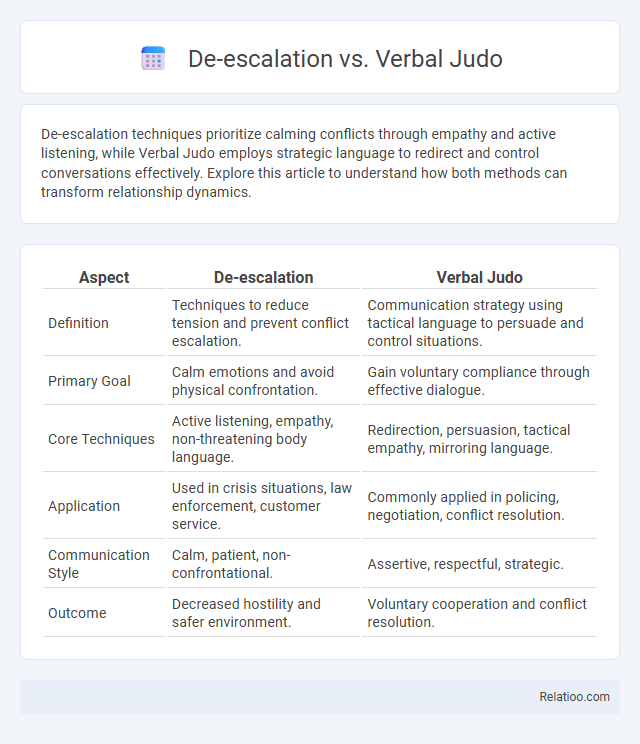De-escalation techniques prioritize calming conflicts through empathy and active listening, while Verbal Judo employs strategic language to redirect and control conversations effectively. Explore this article to understand how both methods can transform relationship dynamics.
Table of Comparison
| Aspect | De-escalation | Verbal Judo |
|---|---|---|
| Definition | Techniques to reduce tension and prevent conflict escalation. | Communication strategy using tactical language to persuade and control situations. |
| Primary Goal | Calm emotions and avoid physical confrontation. | Gain voluntary compliance through effective dialogue. |
| Core Techniques | Active listening, empathy, non-threatening body language. | Redirection, persuasion, tactical empathy, mirroring language. |
| Application | Used in crisis situations, law enforcement, customer service. | Commonly applied in policing, negotiation, conflict resolution. |
| Communication Style | Calm, patient, non-confrontational. | Assertive, respectful, strategic. |
| Outcome | Decreased hostility and safer environment. | Voluntary cooperation and conflict resolution. |
Understanding De-escalation: Key Principles
Understanding de-escalation involves recognizing its core principles, such as maintaining calmness, active listening, and empathy to defuse tense situations effectively. Verbal Judo, a communication technique rooted in de-escalation, employs strategic language and psychological tactics to redirect aggression and encourage cooperation. Unlike other methods, de-escalation prioritizes reducing conflict through non-threatening dialogue and body language, making it essential for law enforcement, healthcare, and crisis management professionals.
What Is Verbal Judo? Core Concepts
Verbal Judo is a communication technique developed by Dr. George J. Thompson that emphasizes tactical empathy, respect, and effective language to defuse conflict and gain voluntary compliance. Core concepts include the "Five Universal Truths of Human Interaction," active listening, and redirecting negative behavior through calm, authoritative dialogue. Unlike general de-escalation, Verbal Judo provides structured verbal strategies designed to maintain control while preserving dignity and minimizing confrontation.
De-escalation and Verbal Judo: A Historical Overview
De-escalation techniques trace back to early conflict resolution strategies aimed at reducing tension and preventing violence, while Verbal Judo, developed by Dr. George J. Thompson in the 1980s, applies communication principles to defuse confrontations through empathy and tactical dialogue. Both methods prioritize calming aggressive behavior without physical force, but Verbal Judo uniquely integrates linguistic tactics influenced by martial arts philosophy. Your understanding of these approaches enhances conflict management skills by emphasizing respect, control, and effective communication.
Comparing Communication Techniques
De-escalation, Verbal Judo, and negotiation are communication techniques designed to manage conflict, but each approach has distinct strategies. De-escalation relies on calming language and body language to reduce tension, Verbal Judo employs tactical verbal reframing to redirect aggression and maintain control, while negotiation focuses on finding mutually agreeable solutions through dialogue. Your choice of technique should depend on the situation's intensity and desired outcome, ensuring effective conflict resolution and safety.
Psychological Foundations Behind Both Methods
De-escalation and Verbal Judo both rely on psychological principles such as empathy, active listening, and emotional regulation to reduce conflict intensity and promote cooperation. You can effectively use these techniques by understanding underlying cognitive processes like perception management and the importance of maintaining respect to prevent escalation. Both methods emphasize calming triggers and redirecting aggressive behaviors through strategic communication aimed at psychological reassurance.
Practical Applications in Real-life Scenarios
De-escalation techniques prioritize calming tense situations through non-threatening body language and empathetic communication, often used by law enforcement during crisis intervention. Verbal Judo employs persuasive language and tactical empathy to redirect aggressive behavior without physical confrontation, making it essential in customer service and conflict resolution roles. Combining these approaches enhances practical outcomes in real-life scenarios such as hostage negotiations, workplace disputes, and emergency response, minimizing aggression and promoting safety.
Advantages and Limitations of De-escalation
De-escalation techniques emphasize calming tense situations through non-threatening communication, which reduces the risk of physical confrontation and fosters mutual understanding. Advantages of de-escalation include preventing violence, maintaining safety, and promoting cooperation, but its limitations lie in its dependency on the aggressor's willingness to engage and the skill level of the responder. Compared to Verbal Judo, which uses tactical language to redirect behavior, de-escalation prioritizes emotional regulation without confrontational rhetoric, making it less effective in highly aggressive or non-compliant scenarios.
Strengths and Weaknesses of Verbal Judo
Verbal Judo excels in transforming conflict through strategic language and empathy, enhancing officer safety by defusing tense situations without physical force. Its strengths include building rapport and gaining voluntary compliance, but it can be less effective if the subject is highly agitated or non-responsive to verbal cues. Compared to general de-escalation tactics, Verbal Judo demands advanced communication skills and quick thinking, which may limit its application in rapidly evolving scenarios.
Integrating De-escalation and Verbal Judo Approaches
Integrating de-escalation and Verbal Judo techniques enhances conflict resolution by combining calm communication with strategic verbal control to defuse tense situations effectively. Your ability to use empathetic listening alongside respectful, persuasive language increases compliance while reducing aggression in high-pressure encounters. Mastering these complementary approaches leads to safer interactions and more positive outcomes across diverse environments.
Best Practices for Conflict Resolution
Effective conflict resolution relies on combining de-escalation techniques, verbal judo, and clear communication strategies that prioritize empathy and respect. De-escalation focuses on calming heightened emotions, verbal judo uses tactical language to redirect aggression, and best practices include active listening, maintaining calm body language, and avoiding provocative statements. Mastery of these approaches enhances the ability to peacefully resolve conflicts while minimizing escalation and fostering mutual understanding.

Infographic: De-escalation vs Verbal Judo
 relatioo.com
relatioo.com